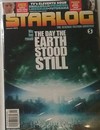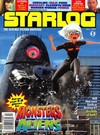Starlog Numbers 341 to 350 Magazine Back Issues01-10 | 11-20 | 21-30 | 31-40 | 41-50 | 51-60 | 61-70 | 71-80 | 81-90 | 91-100 | 101-110 | 111-120 | 121-130 | 131-140 | 141-150 | 151-160 | 161-170 | 171-180 | 181-190 | 191-200 | 201-210 | 211-220 | 221-230 | 231-240 | 241-250 | 251-260 | 261-270 | 271-280 | 281-290 | 291-300 | 301-310 | 311-320 | 321-330 | 331-340 | 341-350
|
Starlog # 369

|
Starlog # 369 Features
City Of Ember Iron Man Incredible Hulk
Torchwood Ghost Town Spider - Man
The Jedi Return In An All New CG Movie And TV Series
Secret Of Voyage To The Bottom Of The Sea
| |
|
|
|
|
Starlog # 372

|
Starlog # 372 Features
Quantum Of Solace Getting Inside James Dead's Head
TV's Eleventh Hour Smallville Primeval Librarian Futurama
The Science Fiction Universe
Why They Remade The Day The Earth Stood Still
| |
|
|
|
|
Starlog # 374

|
Starlog # 374 Features
Coraline Hulk Push Inkheart Eleventh Hour Wonder Woman Fringe
The Science Fiction Universe
Will They Save Earth Or Destroy It? Or A Little Of Both?
Put On Your 3 - D Glasses For
| |
|
|
|
Starlog was a monthly science fiction magazine that was created in 1976 and focused primarily on Star Trek at its inception. Kerry O’Quinn and Norman Jacobs were its creators and it was published by Starlog Group, Inc. in August 1976. Starlog was one of the first publications to report on the development of the first Star Wars movie, and it followed the development of what was to eventually become Star Trek: The Motion Picture (1979).
Starlog was born out of the Star Trek fandom craze, but also was inspired by the success of the magazine Cinefantastique which was the model of Star Trek and Star Wars coverage. Starlog, though it called itself a science fiction magazine, actually contained no fiction. The primary focus of the magazine, besides the fact that it was mostly based on Star Trek fandom, was the making of science fiction media - books, films, and television series - and the work that went into these creations. The magazine examined the form of science fiction and used interviews and features with artists and writers as its foundation.
Science fiction fans, such as those who follow the television channel SyFy, have voiced that Starlog is the science fiction magazine most responsible for cultivating and exhibiting fanboy culture in America during the magazine’s heyday in the 1970s through the early 1990s. Not only did the magazine cover media, the way it was created, and by whom, but they also attended conventions such as the “Ultimate Fantasy” convention in Houston, Texas in 1982 (which was a legendary flop) and kept fans updated on the current events in their respective sci-fi fandoms. Starlog itself followed the marketing strategy of labeling it “the most popular science fiction magazine in publishing history” which allowed the creators to home in on their fanboy market and use that advertisement strategy to their advantage. In later years many of its long-time contributors had moved on. Nonetheless, it continued to boast genre journalists such as Jean-Marc Lofficier, Will Murray, and Tom Weaver.
Starlog ended its run as a digital magazine published by The Brooklyn Company, run by longtime Fangoria President Thomas DeFeo. In April 2009, Starlog officially ended its time in print, with 33 years of material (374 issues).
Login
| Complaints
| Blog
| Games
| Digital Media
| Souls
| Obituary
| Contact Us
| FAQ
CAN'T FIND WHAT YOU'RE LOOKING FOR? CLICK HERE!!!
|



